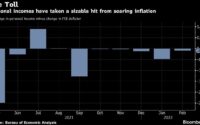The great migration during the pandemic has seen Americans flee high-tax Democrat-run states and flock to Republican-led low-tax or no-income-tax states, a study by The Tax Foundation found.
‘People move to states with low-income tax for a multitude of reasons, sometimes it’s the most direct and obvious reason that it reduces their own tax liability,’ the vice president of state projects at the Tax Foundation, Jared Walczak, told Yahoo.
‘Especially now that people have more capacity to move where they want, that will be a higher priority for some,’ he added.
The analysis contrasted data from the US Census Bureau released last year, along with commercial datasets released this week by U-Haul and United Van Lines.
Low or no-personal-income states such as Utah, Montana, Arizona, South Carolina, Delaware, Texas, Nevada, Florida, and North Carolina all saw population gains of 1 percent or more.
Meanwhile, District of Columbia and New York – the only two to raise personal income taxes in 2021 – shrunk significantly in population.

After the pandemic hit, Americans have flocked to no-tax or low-income-tax states, a study by The Tax Foundation found

The report suggests that Americans have tried to escape the burden of high income taxes. Above, Ethan Miller works on his taxes at home in Silver Spring, Md, on January 21

New York, where income taxes were raised in 2021, lost 1.8percent of its population from July 2020 to July 2021, while DC also saw a decline of 2.8percent in population during the same period
Of the 50 US states, 42 and DC have individual income taxes. In 41 of those states, income from wages and salaries are considered taxes.

The vice president of state projects at the Tax Foundation, Jared Walczak, warned that those ditching high-tax states are not just retirees but also young people who have flexibility to work from anywhere
Alaska, Florida, Nevada, South Dakota, Tennessee, Texas, Washington and Wyoming do not have a state income tax.
District of Columbia, where income taxes were raised last year, saw a decline in population of 2.8percent between April 2020 and July 2021, according to Census data.
New York lost 1.8percent of its population.
The states with the highest personal income taxes, California, Hawaii, New Jersey and Illinois, experienced the most staggering population losses.
New Jersey dropped by 12,613 people between July 2020 and July 2021, according to the Garden State’s website.
California, where rates range from 1percent to 13.30percent based on income, saw its population decline by 173,000 during the same period.
Illinois has also experienced a population decline of more than 100,000, roughly the size of its capital, since 2020.
Texas, one of the eight states without individual income tax, gained around 310,288 people, a 1.1percent increase.
Florida grew by 211,196 residents while North Carolina saw the country’s fourth-highest population growth and added nearly 94,000 people.
South Carolina gained 59,976 residents.
Nine states that saw population gains either implemented or enacted cuts to the individual or corporate income tax rates last year, the report said.
However, Walzack warned that population changes across the country are not solely to blame for the trend. ‘There are also second-order effects,’ Walczak told Yahoo.
‘States with lower tax burdens and with more pro growth tax codes have higher rates of growth and higher economic opportunity – and people will move to seek out those things even beyond their own tax burdens,’ he added.
In addition to the report’s findings on how burdening local taxes are to Americans, Walczak added that those ditching high-tax states are not just retirees.
‘Typically, state-to-state migration is led by retirees leaving colder and high-tax states for ones with low or no income taxes that often have warmer climates. Not now, necessarily,’ Walczak said.
He emphasized that now, more than ever, is easier for young people to move across state lines thanks to work-from-home flexibility implemented by companies after the pandemic.
‘This isn’t a migration of just retirees, but more and more a migration of people looking for better economic opportunities,’ Walczak added.


